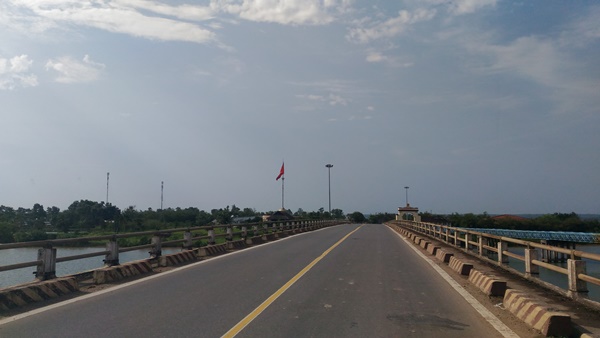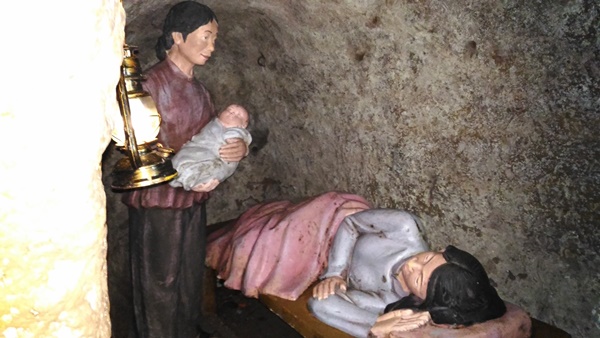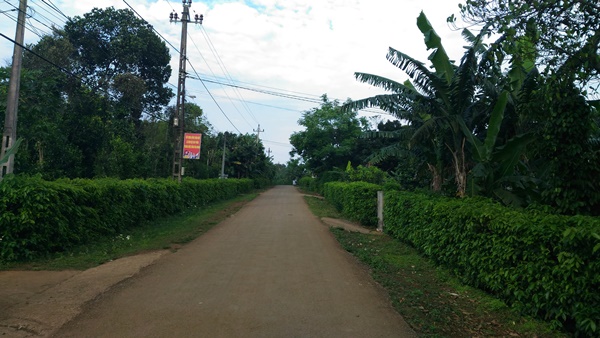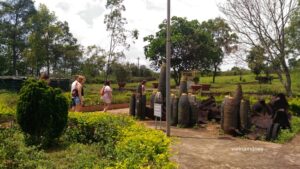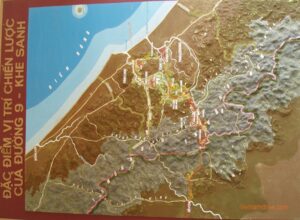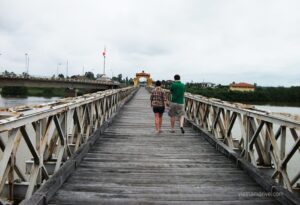START OF LEGEND NEAR DMZ VIETNAM
From 1964 to 1965, while the Village Vinh Linh Quang Tri in the demilitarized zone (DMZ Vietnam) had complicated, the issue of “Militarization for people, being sheltered for the whole area” became the strategy for the existence of this land.
As soon as the first American bomb was dropped onto this land, the system of shelter and ditches was ready.
It was the establishment of A-shelters, basket shelters, tent shelters, and a system of ditches everywhere in the Vinh Linh basaltic land.
A shelter is made of wood with two parts that lean against each other on top of each other; its foot is stretched like an A-shape. The tent shelter is rectangular, with a square hole. The top of the hole was strengthened by wood and covered by soil, and the shelter door was connected to the ditches.
This kind of shelter was located near the residence area, close to roads, fields, and the sea, so people could easily find shelter when there was an alarm. Sometimes, when there were so many bombards and artilleries, shelters became health stations, schools, kindergartens, and food storehouses. The system of ditches connected house-to-house, village-to-village, and commune-to-commune.
By the middle of 1966, there were 1,300 shelters in Vinh Linh, and the total length of ditches was 1,300 kilometers, equal to half the size of the country. The land split itself to protect people. As the enemy madly poured into this land with heavy weapons, shelters on the surface of the land were unable to protect people; the local Party and people made a new decision: going deep into their homeland, a testament to their unwavering determination and resilience.
SYSTEM OF UNDERGROUND SHELTERS FOR VILLAGES IN VINH LINH – THE MIRACULOUS LEGEND OF THE TWENTIETH CENTURY
The underground shelters for villages as tunnels first appeared in Vietnam in 1947 at the resistance zone Phu Tho Hoa (Tan Binh – Ho Chi Minh). There were shelters deep under the ground connected by ditches at that place. Then, from 1961 to 1965, the tunnel at Cu Chi appeared in all five communes.
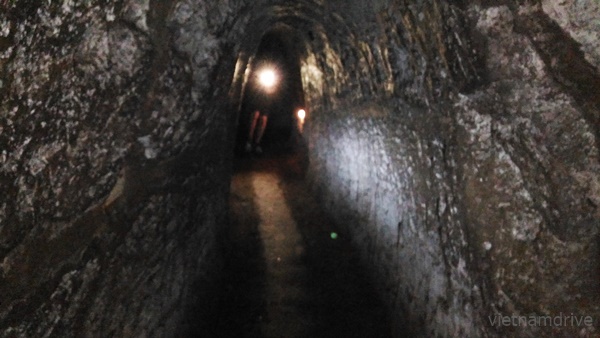
By the end of 1963, Mr Tran Nam Trung from the Southern Central Committee was dropped by Vinh Giang commune (Vinh Linh) on the way from the South to the North. After studying topography and the geological features of the land, he recommended Vinh Linh to dig the tunnel as Cu Chi had. Because shelters on the ground surface were often destroyed by bombs and considering his opinion, the Party saw the tunnel would be the safer shelter in the basaltic land in Vinh Linh Quang Tri. The Party of the area decided to assign the Military Headquarters, the borderline police force, and the Party of Vinh Giang commune to study the situation for the trial of digging tunnels.
Then, the trial force (mainly guerrilla and well-digging workers) dug a tunnel 50 meters long and 6 – 7 meters deep at Tan My village. This was considered the first tunnel in Vinh Linh.
Not long after the first trial tunnel, most villages, especially in the East of Vinh Linh, such as Vinh Giang, Vinh Quang, Vinh Thac, Vinh Hien, Vinh Hoa, Vinh Kim, and Vinh Nam, where there is basaltic land, started digging tunnels.
By the middle of 1966, there were dozens of tunnels in Vinh Linh. However, those tunnels are short and not very deep in the ground, so they are called small or medium tunnels.
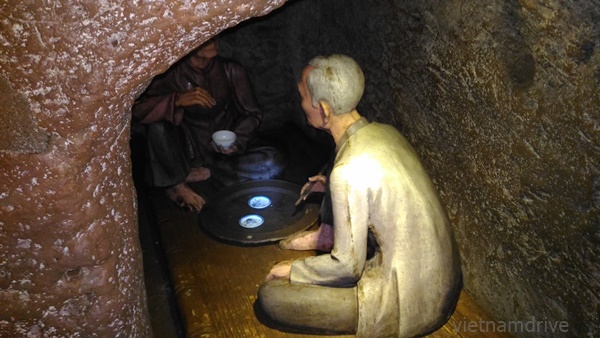
Lessons from the successes and failures of the war were not only sweat but blood as well. For the first experiment in the increasing war, the small and medium tunnel systems did not meet the safety for fights and shelters. Sometimes, there were significant losses of lives. For example, the Don Due tunnel (Vinh Hoa) collapsed by a bomb on February 26th, 1967, and 4 people died; the Tan Ly tunnel (Vinh Quang) collapsed on July 27th, 1967, and 22 people died; the Binh Minh tunnel (Vinh Hien) was collapsed on September 10th, 1967 and 39 people died.
The more American imperialism tried to destroy, the stronger the will for existence and victory by the people of this land was. With the slogans: “Each hamlet, each village is fighting stronghold,” “the whole Vinh Linh started so march deep into the ground. Every house, hamlet and people dug tunnels”.
By the end of 1968, almost 70 villages of 15 communes in Vinh Linh had tunnels. At that time, tunnels were not simply shelters and fighting posts like Cu Chi tunnels. They became existing environments. The living” submerged” deep 30 meters into the ground.
If counting typical tunnels in Vinh Linh Quang Tri, there were 114 village tunnels with a total length of more than 40 kilometers. This has yet to count 2.000 kilometers of ditches and the system of thousands of small and medium tunnels.
The advantages of the village tunnels were that they had more wells and doors, were longer, and were deeper. All these factors made tunnels stronger and easier to rescue people in case they collapsed.
Each village tunnel includes one main tunnel going through the residency area or through hills (the length of the main tunnel is dependent on its usage and function). From the main tunnel, branches connect house shelters, kitchens, storage, wells, and doors. Most tunnels were made with a vault over the head and a flat platform. The average height is 1.6 – 1.9 meters, and the width is 0.9 – 1.3 meters.
It is noted that Vinh Linh Quang Tri tunnels are in a Z-shape to strengthen them in zigzag points. Tunnels often have sudden turns at the entrances or exits, which help prevent bombs or ammunition from getting inside.
The system of tunnels in Vinh Linh is, in fact, for a village living under the ground. The village here got its full meaning: homes, meeting halls, health posts, the place for local authorities, schools, kindergartens, storehouses, and kitchens. This underground community was a symbol of unity and shared struggle.
To set up “a miracle in the ground,” people of “the firing land” – Vinh Linh had to spend a lot of materials, labor, time, and even lives.
Digging tunnels was extremely difficult and dangerous: digging under the storm of bombs and ammunition. If any sign of new soil were detected, the enemy would immediately drop tons of bombs on that place. Bombards caused losses to many places where people were digging tunnels.
Many simple or modern tools were mobilized for “exploring the ground.” Hundreds of wood houses were taken apart to support the tunnel arch. The song of that time still sounds here and there.
“Regardless of collapsed or destroyed house
Accepting the difficulties of winning the fight against
American army for a better life in the future”.
Digging a tunnel started with a drawing and the estimated measurement on the ground. The people dug wells 50 meters apart. Each group of 4 – 5 people started the ground exploration by digging wells to a certain depth. Then, they patiently dug the tunnel in the direction of each other. The theory seemed easy, but the reality was not. People meeting each other on the ground daily would find it difficult to get in contact deep in the ground. They looked like people from different planets looking for communication signals.
Sometimes, they dug the tunnel longer than expected but did not see their partners on the other end. They beat on the wall of the tunnel, silently listening to the echo of the ground. Somewhere on the left, the right, or above, in the motherland’s darkness, people longed to see each other. The search for their partners on the ground reflected something ancient but full of the strong faith of the Ho Chi Minh generation in the independence and freedom of an immortal nation.
Such are the difficulties and constraints. With hard work, creativity, and great effort, Vinh Linh’s military forces and people made a massive construction for three years (1966-1968): digging 3.759.270m3 of soil to set up a system of tunnels under the ground during the fierce war.
Each tunnel was a miniature of each village in the ground. The main tunnel was the village path; shelters were houses. The community hall would be the meeting hall in the tunnel for 40-80 people’s meetings. It was a place for people to gather for discussion and art performances. In addition, there were wells, kindergartens, nursery houses, and health stations.
Indeed, living under the ground is not easy, and most tunnels have to save kerosene and fat for light. As a result, more light was needed in the tunnel except for meetings, patients, and childbirth.
Cooking had to be done in the tunnel. Smoke was prohibited from appearing on the ground and in the sky because the enemy could detect the location and drop tons of bombs. Vinh Linh people created the Hoang Cam cooker, a testament to their ingenuity and resourcefulness, which can limit smoke rising apparently above the ground (there were small tunnels to disperse smoke before letting smoke rise on the ground).
More than 60 babies were born in the tunnels, which had special shelters for birth delivery and child care. In the utmost difficulties of life, the smiles of children were still heard as a symbol of the immortality of people in this land.
The singing voice would never be choked. In every village, there was an art team. The whole Vinh Linh was full of singing because there was one slogan: “The singing voice outweighed the noises of bombs.”
The tunnels in Vinh Linh were not only the residences and activities of villages but also the working places of local governments and the military forces.
The area Party of Vinh Linh and the Administration Committee was in the concrete tunnel in Vinh Tien – Nam Ho (Ho Xa Township), Nam Hung (Vinh Nam), and Hien Dung (Vinh Hoa). Commune authorities often selected crowded villages with sizable tunnels as their workplaces.
For military purposes and secrecy, the army forces had their tunnels at Tram village (An Du Nam), Cua Tung (Vinh Quang), Tung Luat (Vinh Giang), Team 7 (Thuy Trung – Vinh Trung), Khe Ho (Vinh Ha), Mui Si (Vinh Thach). In addition, all other tunnels dug by people are local soldiers in the area, sometimes with a considerable number.
In addition, the village tunnels in Vinh Linh are storage places for food and arms. They could store dozens of tons of food and goods from the North to the South and Con Co Island.
After 1972, two-thirds of Quang Tri province was liberated. The system of village tunnels became valuable historical remains that remind us of the heroic and brave times of local people and military forces of the heroic “Steel stronghold.” They became “the ancient castles of so many miracles about the people who founded them and about the time that they were born in.”
Quang Tri Management Board of Relics and Tourist Sights

